YAMAHA YZF600 2001 Repair Manual
Manufacturer: YAMAHA, Model Year: 2001, Model line: YZF600, Model: YAMAHA YZF600 2001Pages: 114, PDF Size: 12.39 MB
Page 61 of 114
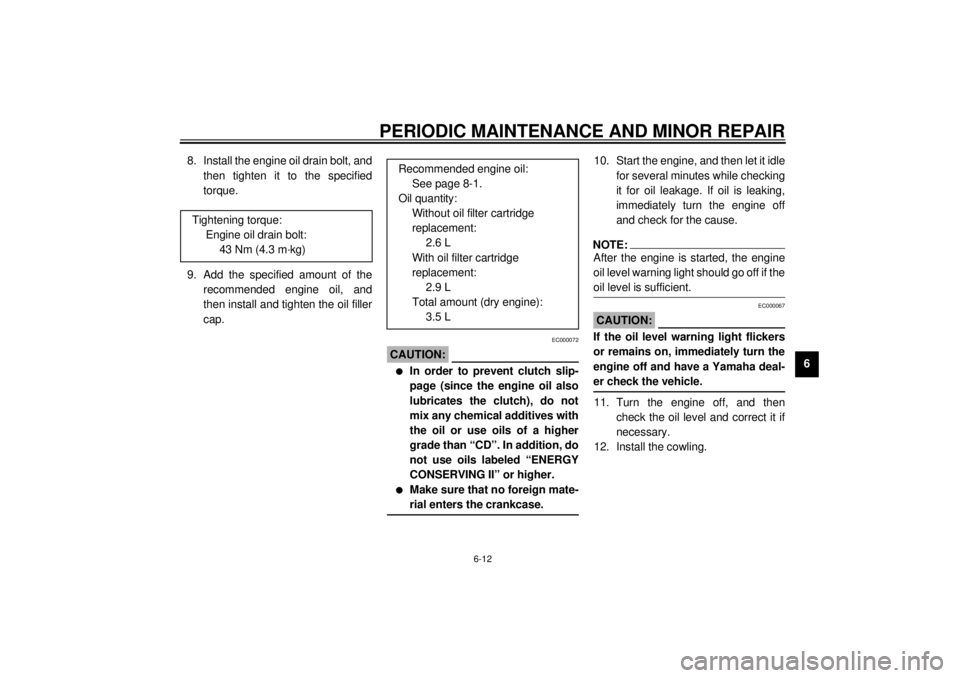
PERIODIC MAINTENANCE AND MINOR REPAIR
6-12
6 8. Install the engine oil drain bolt, and
then tighten it to the specified
torque.
9. Add the specified amount of the
recommended engine oil, and
then install and tighten the oil filler
cap.
EC000072
CAUTION:_ l
In order to prevent clutch slip-
page (since the engine oil also
lubricates the clutch), do not
mix any chemical additives with
the oil or use oils of a higher
grade than “CD”. In addition, do
not use oils labeled “ENERGY
CONSERVING II” or higher.
l
Make sure that no foreign mate-
rial enters the crankcase.
_
10. Start the engine, and then let it idle
for several minutes while checking
it for oil leakage. If oil is leaking,
immediately turn the engine off
and check for the cause.NOTE:_ After the engine is started, the engine
oil level warning light should go off if the
oil level is sufficient. _
EC000067
CAUTION:_ If the oil level warning light flickers
or remains on, immediately turn the
engine off and have a Yamaha deal-
er check the vehicle. _11. Turn the engine off, and then
check the oil level and correct it if
necessary.
12. Install the cowling. Tightening torque:
Engine oil drain bolt:
43 Nm (4.3 m·kg)
Recommended engine oil:
See page 8-1.
Oil quantity:
Without oil filter cartridge
replacement:
2.6 L
With oil filter cartridge
replacement:
2.9 L
Total amount (dry engine):
3.5 L
E_4tv.book Page 12 Wednesday, October 4, 2000 2:15 PM
Page 62 of 114
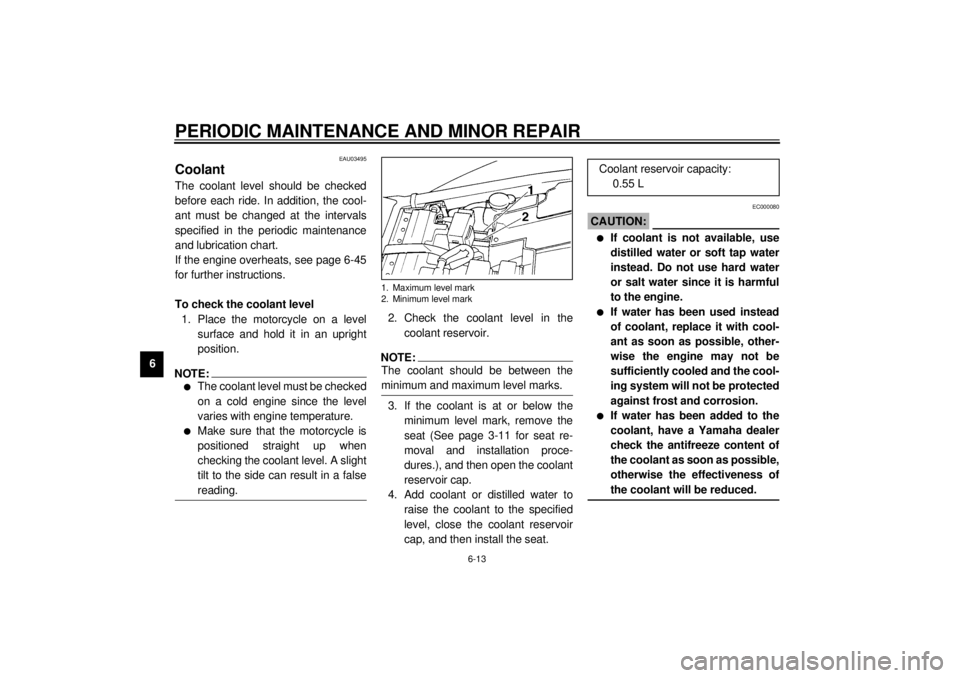
PERIODIC MAINTENANCE AND MINOR REPAIR
6-13
6
EAU03495
Coolant The coolant level should be checked
before each ride. In addition, the cool-
ant must be changed at the intervals
specified in the periodic maintenance
and lubrication chart.
If the engine overheats, see page 6-45
for further instructions.
To check the coolant level
1. Place the motorcycle on a level
surface and hold it in an upright
position.NOTE:_ l
The coolant level must be checked
on a cold engine since the level
varies with engine temperature.
l
Make sure that the motorcycle is
positioned straight up when
checking the coolant level. A slight
tilt to the side can result in a false
reading.
_
2. Check the coolant level in the
coolant reservoir.NOTE:_ The coolant should be between the
minimum and maximum level marks. _3. If the coolant is at or below the
minimum level mark, remove the
seat (See page 3-11 for seat re-
moval and installation proce-
dures.), and then open the coolant
reservoir cap.
4. Add coolant or distilled water to
raise the coolant to the specified
level, close the coolant reservoir
cap, and then install the seat.
EC000080
CAUTION:_ l
If coolant is not available, use
distilled water or soft tap water
instead. Do not use hard water
or salt water since it is harmful
to the engine.
l
If water has been used instead
of coolant, replace it with cool-
ant as soon as possible, other-
wise the engine may not be
sufficiently cooled and the cool-
ing system will not be protected
against frost and corrosion.
l
If water has been added to the
coolant, have a Yamaha dealer
check the antifreeze content of
the coolant as soon as possible,
otherwise the effectiveness of
the coolant will be reduced.
_
1. Maximum level mark
2. Minimum level mark
Coolant reservoir capacity:
0.55 L
E_4tv.book Page 13 Wednesday, October 4, 2000 2:15 PM
Page 63 of 114
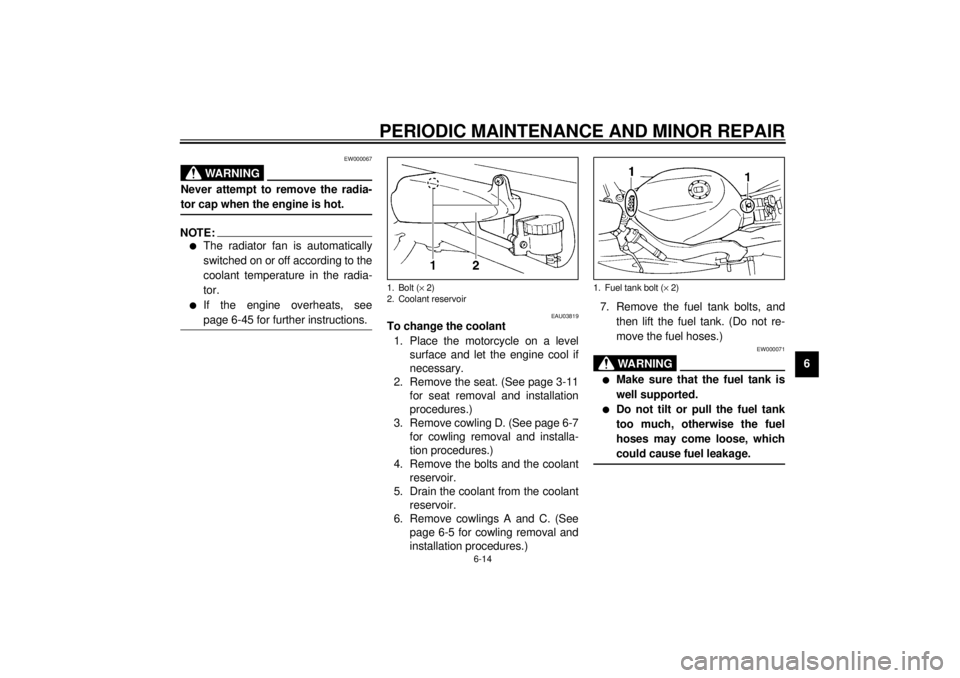
PERIODIC MAINTENANCE AND MINOR REPAIR
6-14
6
EW000067
WARNING
_ Never attempt to remove the radia-
tor cap when the engine is hot. _NOTE:_ l
The radiator fan is automatically
switched on or off according to the
coolant temperature in the radia-
tor.
l
If the engine overheats, see
page 6-45 for further instructions.
_
EAU03819
To change the coolant
1. Place the motorcycle on a level
surface and let the engine cool if
necessary.
2. Remove the seat. (See page 3-11
for seat removal and installation
procedures.)
3. Remove cowling D. (See page 6-7
for cowling removal and installa-
tion procedures.)
4. Remove the bolts and the coolant
reservoir.
5. Drain the coolant from the coolant
reservoir.
6. Remove cowlings A and C. (See
page 6-5 for cowling removal and
installation procedures.)7. Remove the fuel tank bolts, and
then lift the fuel tank. (Do not re-
move the fuel hoses.)
EW000071
WARNING
_ l
Make sure that the fuel tank is
well supported.
l
Do not tilt or pull the fuel tank
too much, otherwise the fuel
hoses may come loose, which
could cause fuel leakage.
_
1. Bolt (´ 2)
2. Coolant reservoir
1. Fuel tank bolt (´ 2)
E_4tv.book Page 14 Wednesday, October 4, 2000 2:15 PM
Page 64 of 114

PERIODIC MAINTENANCE AND MINOR REPAIR
6-15
68. Remove the right air intake duct by
loosening the screw clamps.9. Remove the radiator cap.
EW000067
WARNING
_ Never attempt to remove the radia-
tor cap when the engine is hot. _10. Place a container under the en-
gine to collect the used coolant11. Remove the water pump drain bolt
to drain the cooling system.
12. Remove the cylinder drain bolts to
drain the cooling system.
13. After the coolant is completely
drained, thoroughly flush the cool-
ing system with clean tap water.
14. Install the water pump drain bolt
and cylinder drain bolts, and then
tighten them to the specified
torques.
1. Screw clamp (´ 2)
2. Right air intake duct
1. Radiator cap
1. Water pump drain bolt
2. Cylinder drain bolt (´ 2)
E_4tv.book Page 15 Wednesday, October 4, 2000 2:15 PM
Page 65 of 114
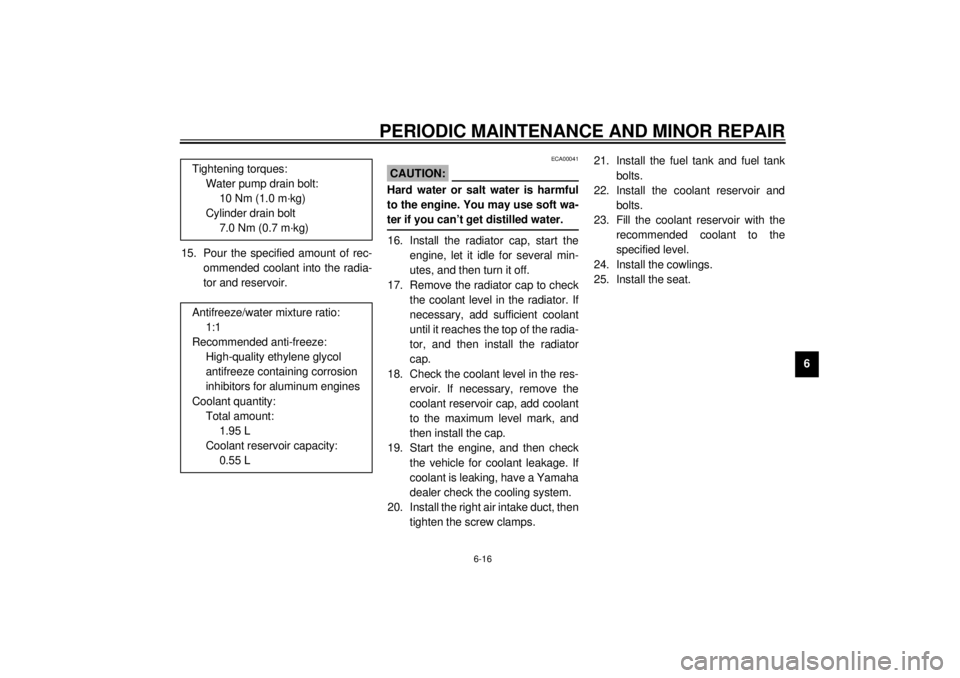
PERIODIC MAINTENANCE AND MINOR REPAIR
6-16
6 15. Pour the specified amount of rec-
ommended coolant into the radia-
tor and reservoir.
ECA00041
CAUTION:_ Hard water or salt water is harmful
to the engine. You may use soft wa-
ter if you can’t get distilled water. _16. Install the radiator cap, start the
engine, let it idle for several min-
utes, and then turn it off.
17. Remove the radiator cap to check
the coolant level in the radiator. If
necessary, add sufficient coolant
until it reaches the top of the radia-
tor, and then install the radiator
cap.
18. Check the coolant level in the res-
ervoir. If necessary, remove the
coolant reservoir cap, add coolant
to the maximum level mark, and
then install the cap.
19. Start the engine, and then check
the vehicle for coolant leakage. If
coolant is leaking, have a Yamaha
dealer check the cooling system.
20. Install the right air intake duct, then
tighten the screw clamps.21. Install the fuel tank and fuel tank
bolts.
22. Install the coolant reservoir and
bolts.
23. Fill the coolant reservoir with the
recommended coolant to the
specified level.
24. Install the cowlings.
25. Install the seat. Tightening torques:
Water pump drain bolt:
10 Nm (1.0 m·kg)
Cylinder drain bolt
7.0 Nm (0.7 m·kg)
Antifreeze/water mixture ratio:
1:1
Recommended anti-freeze:
High-quality ethylene glycol
antifreeze containing corrosion
inhibitors for aluminum engines
Coolant quantity:
Total amount:
1.95 L
Coolant reservoir capacity:
0.55 L
E_4tv.book Page 16 Wednesday, October 4, 2000 2:15 PM
Page 66 of 114
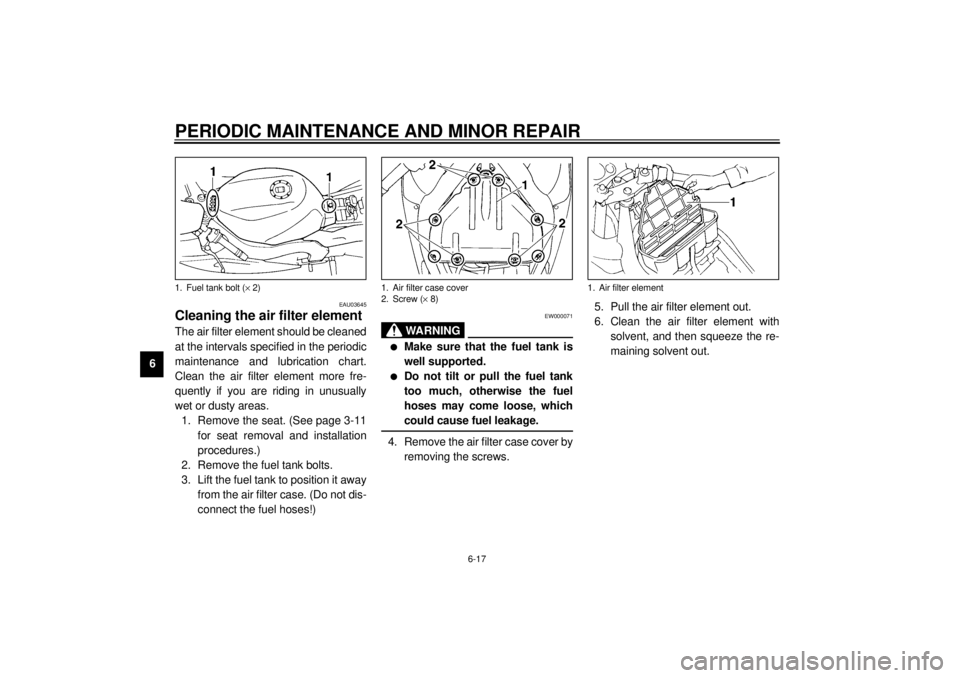
PERIODIC MAINTENANCE AND MINOR REPAIR
6-17
6
EAU03645
Cleaning the air filter element The air filter element should be cleaned
at the intervals specified in the periodic
maintenance and lubrication chart.
Clean the air filter element more fre-
quently if you are riding in unusually
wet or dusty areas.
1. Remove the seat. (See page 3-11
for seat removal and installation
procedures.)
2. Remove the fuel tank bolts.
3. Lift the fuel tank to position it away
from the air filter case. (Do not dis-
connect the fuel hoses!)
EW000071
WARNING
_ l
Make sure that the fuel tank is
well supported.
l
Do not tilt or pull the fuel tank
too much, otherwise the fuel
hoses may come loose, which
could cause fuel leakage.
_4. Remove the air filter case cover by
removing the screws.5. Pull the air filter element out.
6. Clean the air filter element with
solvent, and then squeeze the re-
maining solvent out.
1. Fuel tank bolt (´ 2)
1. Air filter case cover
2. Screw (´ 8)
1. Air filter element
E_4tv.book Page 17 Wednesday, October 4, 2000 2:15 PM
Page 67 of 114
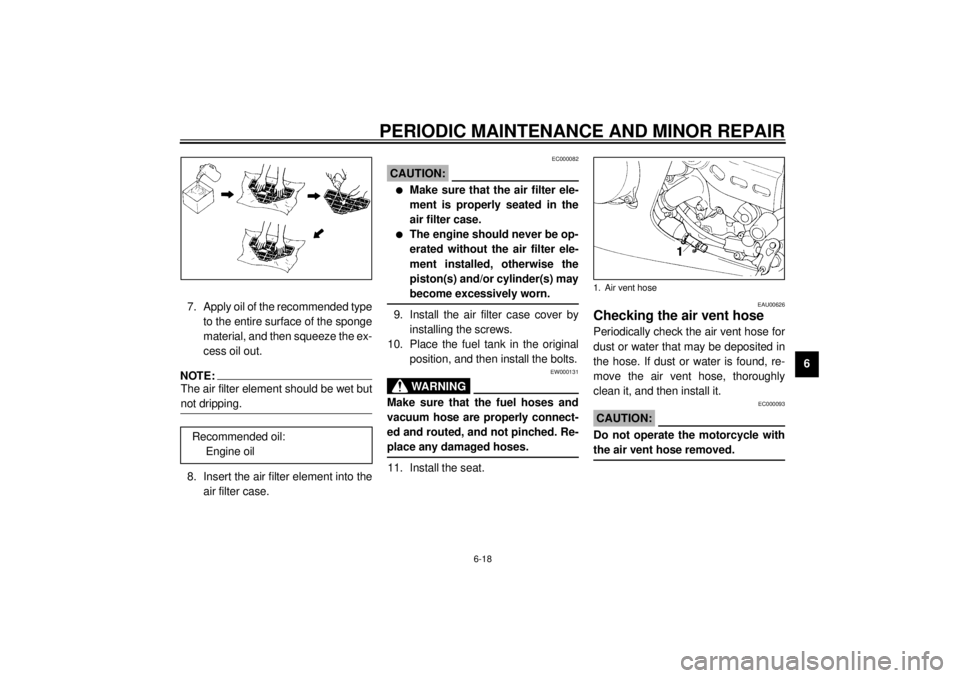
PERIODIC MAINTENANCE AND MINOR REPAIR
6-18
6 7. Apply oil of the recommended type
to the entire surface of the sponge
material, and then squeeze the ex-
cess oil out.
NOTE:_ The air filter element should be wet but
not dripping. _8. Insert the air filter element into the
air filter case.
EC000082
CAUTION:_ l
Make sure that the air filter ele-
ment is properly seated in the
air filter case.
l
The engine should never be op-
erated without the air filter ele-
ment installed, otherwise the
piston(s) and/or cylinder(s) may
become excessively worn.
_9. Install the air filter case cover by
installing the screws.
10. Place the fuel tank in the original
position, and then install the bolts.
EW000131
WARNING
_ Make sure that the fuel hoses and
vacuum hose are properly connect-
ed and routed, and not pinched. Re-
place any damaged hoses. _11. Install the seat.
EAU00626
Checking the air vent hose Periodically check the air vent hose for
dust or water that may be deposited in
the hose. If dust or water is found, re-
move the air vent hose, thoroughly
clean it, and then install it.
EC000093
CAUTION:_ Do not operate the motorcycle with
the air vent hose removed. _
Recommended oil:
Engine oil
1. Air vent hose
E_4tv.book Page 18 Wednesday, October 4, 2000 2:15 PM
Page 68 of 114
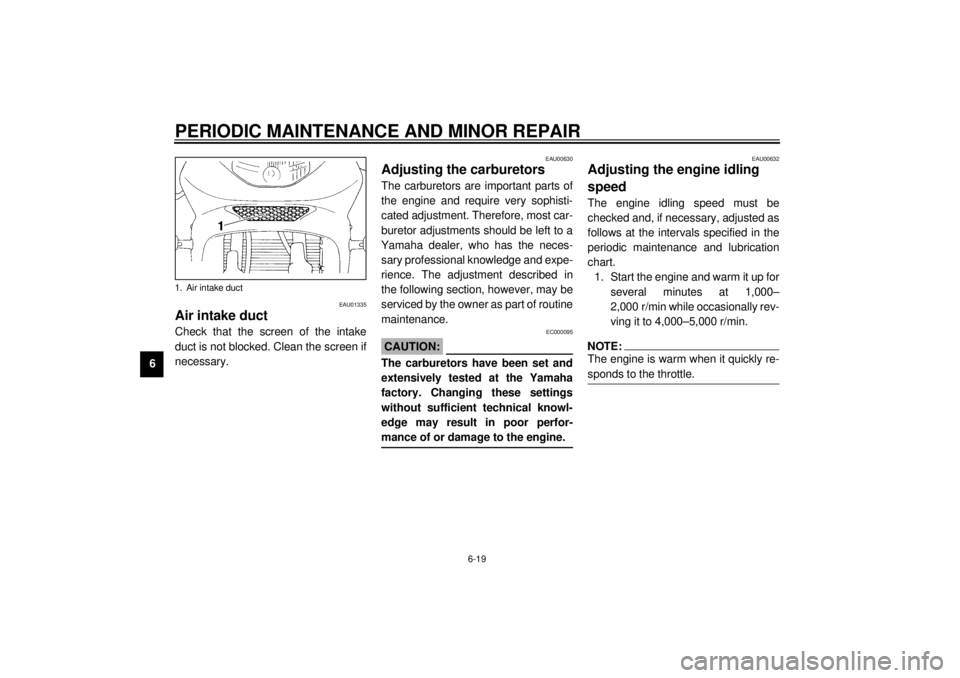
PERIODIC MAINTENANCE AND MINOR REPAIR
6-19
6
EAU01335
Air intake duct Check that the screen of the intake
duct is not blocked. Clean the screen if
necessary.
EAU00630
Adjusting the carburetors The carburetors are important parts of
the engine and require very sophisti-
cated adjustment. Therefore, most car-
buretor adjustments should be left to a
Yamaha dealer, who has the neces-
sary professional knowledge and expe-
rience. The adjustment described in
the following section, however, may be
serviced by the owner as part of routine
maintenance.
EC000095
CAUTION:_ The carburetors have been set and
extensively tested at the Yamaha
factory. Changing these settings
without sufficient technical knowl-
edge may result in poor perfor-
mance of or damage to the engine. _
EAU00632
Adjusting the engine idling
speed The engine idling speed must be
checked and, if necessary, adjusted as
follows at the intervals specified in the
periodic maintenance and lubrication
chart.
1. Start the engine and warm it up for
several minutes at 1,000–
2,000 r/min while occasionally rev-
ving it to 4,000–5,000 r/min.NOTE:_ The engine is warm when it quickly re-
sponds to the throttle. _
1. Air intake ductE_4tv.book Page 19 Wednesday, October 4, 2000 2:15 PM
Page 69 of 114
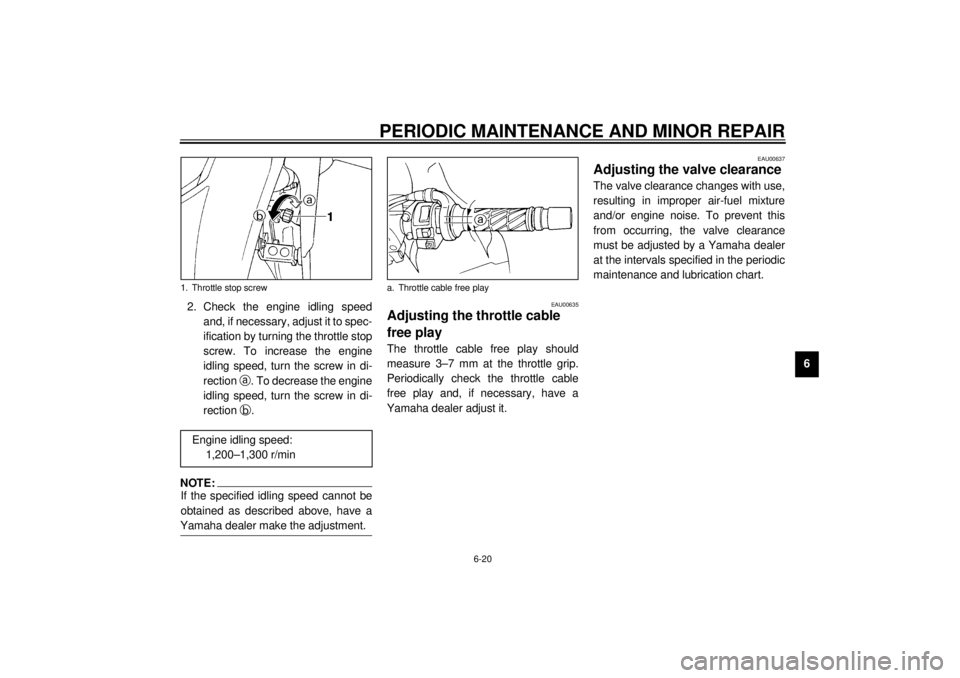
PERIODIC MAINTENANCE AND MINOR REPAIR
6-20
6 2. Check the engine idling speed
and, if necessary, adjust it to spec-
ification by turning the throttle stop
screw. To increase the engine
idling speed, turn the screw in di-
rection
a. To decrease the engine
idling speed, turn the screw in di-
rection
b.
NOTE:_ If the specified idling speed cannot be
obtained as described above, have a
Yamaha dealer make the adjustment. _
EAU00635
Adjusting the throttle cable
free play The throttle cable free play should
measure 3–7 mm at the throttle grip.
Periodically check the throttle cable
free play and, if necessary, have a
Yamaha dealer adjust it.
EAU00637
Adjusting the valve clearance The valve clearance changes with use,
resulting in improper air-fuel mixture
and/or engine noise. To prevent this
from occurring, the valve clearance
must be adjusted by a Yamaha dealer
at the intervals specified in the periodic
maintenance and lubrication chart.
1. Throttle stop screw
Engine idling speed:
1,200–1,300 r/min
a. Throttle cable free play
E_4tv.book Page 20 Wednesday, October 4, 2000 2:15 PM
Page 70 of 114

PERIODIC MAINTENANCE AND MINOR REPAIR
6-21
6
EAU00658
Tires To maximize the performance, durabil-
ity, and safe operation of your motor-
cycle, note the following points
regarding the specified tires.
Tire air pressure
The tire air pressure should be
checked and, if necessary, adjusted
before each ride.
EW000082
WARNING
_ l
The tire air pressure must be
checked and adjusted on cold
tires (i.e., when the temperature
of the tires equals the ambient
temperature).
l
The tire air pressure must be
adjusted in accordance with the
riding speed and with the total
weight of rider, passenger, car-
go, and accessories approved
for this model.
_
CE-01E
CE-07EEWA00012
WARNING
_ Because loading has an enormous
impact on the handling, braking,
performance and safety characteris-
tics of your motorcycle, you should
keep the following precautions in
mind. l
NEVER OVERLOAD THE
MOTORCYCLE! Operation of an
overloaded motorcycle may re-
sult in tire damage, loss of con-
trol, or severe injury. Make sure
that the total weight of rider,
passenger, cargo, and accesso-
ries does not exceed the speci-
fied maximum load for the
vehicle.
l
Do not carry along loosely
packed items, which can shift
during a ride.
Tire air pressure
(measured on cold tires)
Load* Front Rear
Up to 90 kg225 kPa
(2.25 kg/cm
2,
2.25 bar)250 kPa
(2.50 kg/cm
2,
2.50 bar)
90 kg–maximum250 kPa
(2.50 kg/cm
2,
2.50 bar)290 kPa
(2.90 kg/cm
2,
2.90 bar)
High-speed riding250 kPa
(2.50 kg/cm
2,
2.50 bar)290 kPa
(2.90 kg/cm
2,
2.90 bar)
Maximum load*180 kg (except for A, CH, S)
178 kg (for A, CH, S)
* Total weight of rider, passenger, cargo and
accessories
E_4tv.book Page 21 Wednesday, October 4, 2000 2:15 PM